Comprehensive guide to managing your Amazon inventory like a pro
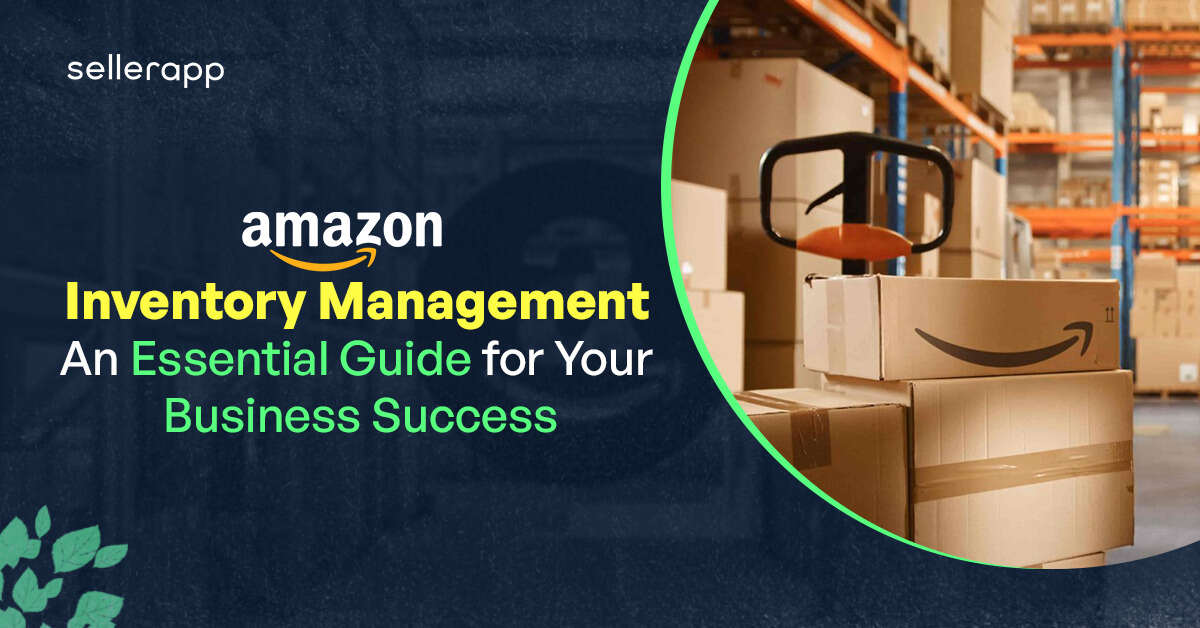
Amazon Inventory Management is the backbone of every successful Amazon seller’s business. While it may lie outside your direct control, its impact on your success cannot be overstated. The availability of your products on the Amazon marketplace is crucial. Also how well you manage your inventory determines the satisfaction of your customers and ultimately influences the trajectory of your brand.
As an Amazon seller, understanding the significance of inventory management is paramount. The persistent inventory challenges can unexpectedly arise and jeopardize your business when least expected.
This article delves into the intricacies of Amazon’s inventory management, exploring each major issue that sellers often encounter. From the perils of stockouts to the risks of overstocking and stranded inventory, we shed light on how these challenges can significantly impact your business performance.
Quick Guide
- What is Amazon Inventory Management?
- Why is Amazon Inventory Management Important?
- How does Amazon Inventory Management Work
- Seven Common Inventory Issues Amazon Sellers Face
- Six Tips to Effectively Manage Your Amazon Inventory
- Conclusion
What is Amazon Inventory Management?
Amazon inventory management combines all the activities that are related to your products, from tracking their availability to efficiently storing them in fulfillment centers. In the highly competitive online platform of Amazon, effective inventory management becomes essential for a smooth and successful business operation.
Proper inventory management is a crucial aspect for any business that sells products, and Amazon’s inventory management is no exception. Its core is all about vigilantly monitoring stock levels. You need to keep a close eye on the quantity of each product you have in inventory to prevent stockouts which can lead to lost sales opportunities and dissatisfied customers. Additionally, you must avoid overstocking, as it can tie up your money and may result in the accumulation of slow-moving or obsolete inventory.
This vital process acts as the backbone of your business, ensuring that you have the right balance between supply and demand. By effectively managing your inventory, you can optimize your product availability, meet customer needs, and enhance your overall supply chain efficiency.
Why is Amazon Inventory Management Important?
In the fast-paced world of online selling, effective Amazon inventory management is crucial for your success. Convenience and early deliveries are crucial factors to satisfy your shoppers. Failing to do so can lead to dissatisfied customers, poor reviews, and lost sales opportunities, which can have a significant impact on your business.
When your products are consistently unavailable, customers will turn to your competitors, and your organic ranking and market share will suffer.
Several other factors impact your inventory management on Amazon, such as
- Supplier manufacturing
- Shipping times
- Customs delays
- FBA storage capacity
- Sell-through rate.
These variables make it challenging to find the right balance between supply and demand, especially when you’re launching new products without historical sales data or customer reviews.
You might find it tricky to determine the appropriate inventory level for a new product initially. Without social proof, like customer reviews, your product might not convert as well as your competitors’ listings.
However, don’t lose hope!
As you gather sales data over time, you can fine-tune your inventory management to avoid stockouts or overstocking. Effectively manage your Amazon inventory to mitigate the risks getting lost in the e-commerce landscape
Remember, successful Amazon inventory management requires continuous monitoring, forecasting, and adjustment based on real-time data and market trends. By understanding demand patterns, supply chain dynamics, and customer preferences, you can optimize your inventory levels to maximize sales. Also, keep your customers happy, and stay ahead of the competition in the ever-evolving Amazon ecosystem.
How does Amazon Inventory Management Work
Firstly, when you choose to use Amazon’s FBA (Fulfillment by Amazon) service, you gain access to their advanced machine learning-based inventory management system. This system takes various factors into account, such as the cost of goods sold, shipment time, and Amazon’s data. It uses these inputs to forecast customer demand and determine the most optimal inventory levels for each product you offer.
Your Inventory Performance Index (IPI) score plays a crucial role in your inventory management process on Amazon. They use this score to evaluate your performance in managing inventory effectively. Your IPI score is influenced by factors like replenishing popular products promptly, maintaining healthy inventory levels, addressing any listing issues, and continuously improving your score to minimize storage costs.
To find your Inventory Performance Index:
- Log in to Amazon Seller Central
- Under the Inventory drop-down menu
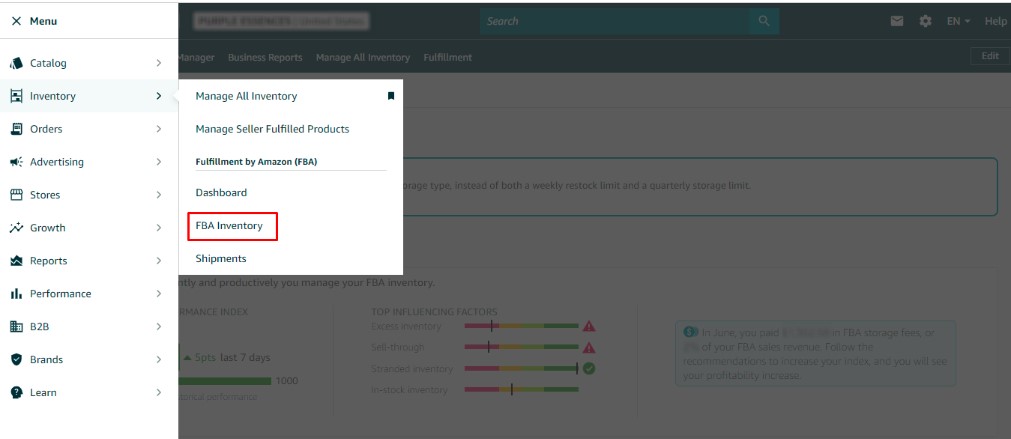
- Navigate to FBA Inventory
- Here you will find a drop-down menu under Inventory
- Click on Inventory Performance
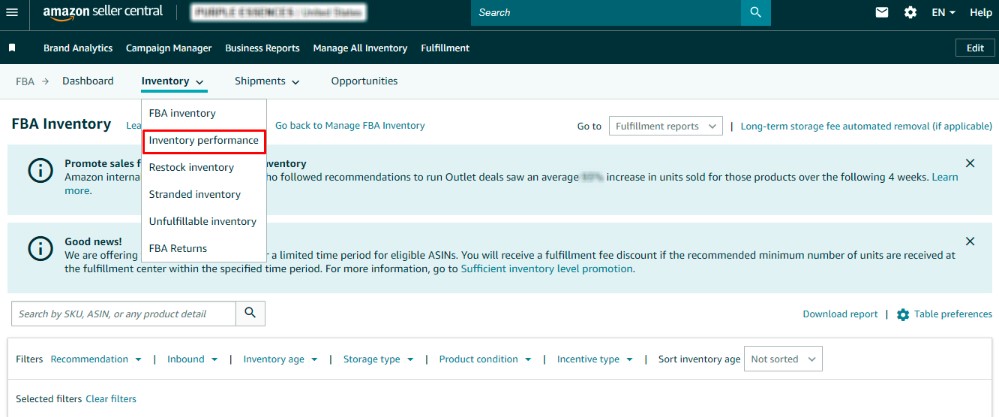
- Here you can find your Inventory Performance and ways to improve your performance
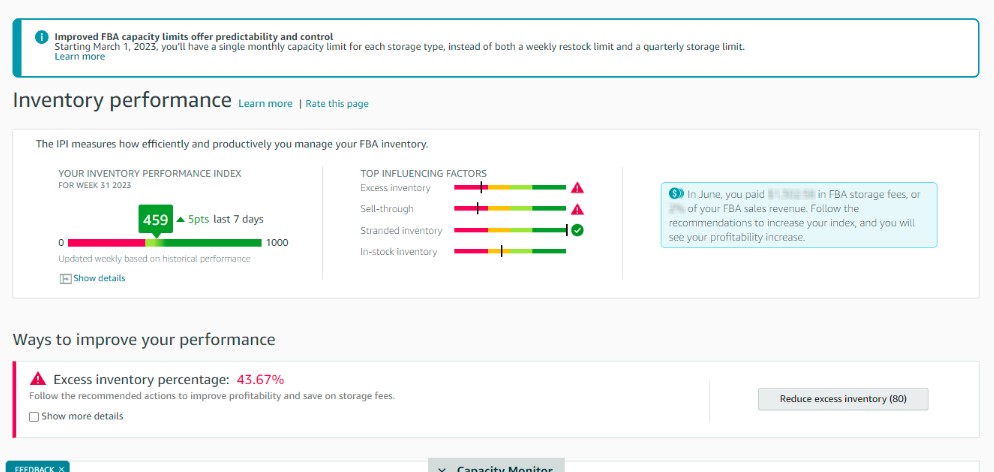
Having a high IPI score comes with its benefits. Sellers with a higher IPI score generally pay less than 1% in storage fees as a percentage of revenue. Moreover, an IPI score above 400 provides you with additional storage capacity in Amazon fulfillment centers, allowing you to expand your product offerings and provide faster shipping options to customers.
However, to effectively manage your inventory, you must be vigilant in tracking your supplier’s manufacturing and shipping times, as well as any customs delays. These external factors can impact your inventory levels and lead to stockouts or overstocking.
Additionally, you need to keep an eye on your sell-through rate—the rate at which your products are sold over a specific period. This metric helps you understand how fast your inventory is moving, enabling you to order new stock accurately and avoid stockouts or excess inventory.
Seven Common Inventory Issues Amazon Sellers Face
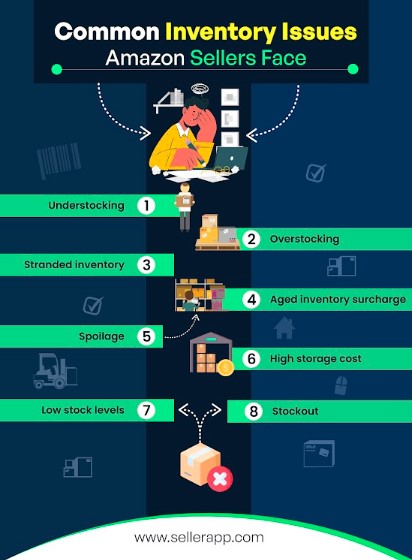
As an Amazon seller, you may encounter several common inventory challenges that can significantly impact your business. It’s crucial to be aware of these issues and take proactive steps to effectively manage your inventory.
Here are the challenges you might face:
Running out of Inventory
You need to stay vigilant and ensure you replenish the stock on time. If you fail to do so, your popular products may become unavailable, resulting in missed sales opportunities.
To find out if you have products in stock in the Amazon Seller Central,
- Log in to Amazon Seller Central
- Click on the left-side menu bar
- Navigate to Inventory
- Select Manage Inventory from the drop-down menu
- Here under the Available column, you can find your items that are in stock.
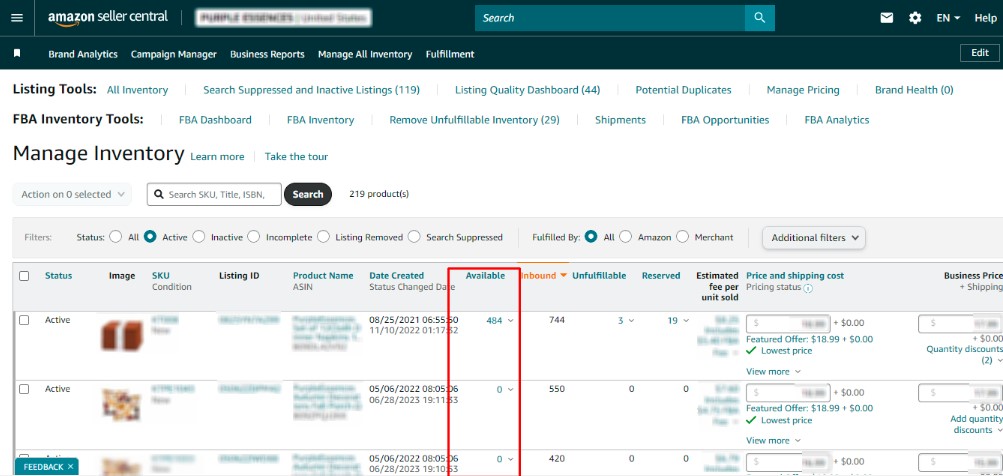
Customers who encounter out-of-stock products are likely to turn to your competitors, which can affect your seller rankings and long-term brand reputation negatively.
The longer you are out of stock, the more it affects your Best Sellers Rank and Organic keyword ranking. Amazon always wants to promote products that are consistently available.
Overstocking Amazon Inventory
Be cautious about ordering excessive quantities of products. If your product has over 90 days of supply or at least one unit aged over 90 days. Amazon considers it as excess inventory. They want the products to move in and out within 90 days of span.
Overstocking can affect your IPI score also and can lead to long-term storage fees, especially if you use Amazon’s FBA program. You need to accurately forecast demand and adjust your inventory levels based on changing market trends to avoid overstocking.
Stranded Inventory
You must pay attention to any issues that cause stranded inventory. Stranded inventory refers to products listed for sale but cannot be fulfilled and shipped to customers. This situation ties up your storage space and capital without generating any revenue, which can impact your profitability.
The worst part is, if your products are not listed for sale, you will still be charged monthly storage fees for each unit.
To fix stranded inventory,
- Go to FBA Inventory
- Under the inventory section, you can find the Stranded Inventory option
- You can find out how to fix your stranded inventory
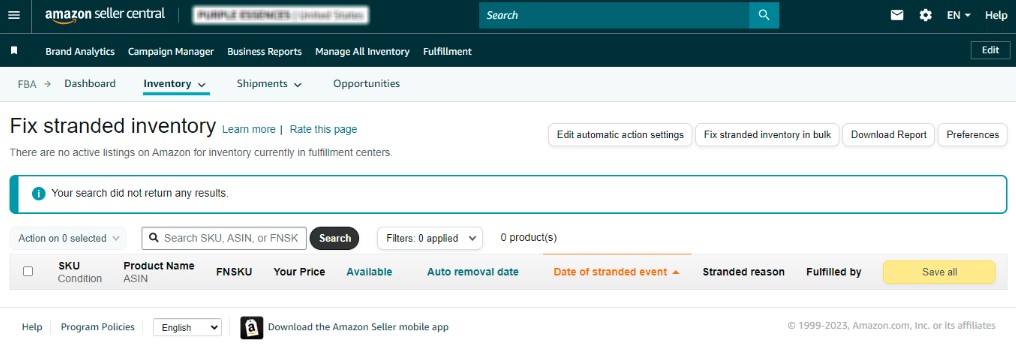
Aged Inventory Surcharge
Amazon imposes an aged inventory surcharge on products that have been in their fulfillment centers for more than 271 days. Amazon will also continue to charge the aged inventory surcharge for units stored for longer than 365 days.
For units aged 271-365 days, you will be charged $1.50 per cubic foot. For units aged 365 days or more, you will be charged $6.90 per cubic foot or $0.15 per unit, whichever is greater.
To avoid this additional fee, effectively managing your inventory is crucial. Aged inventory can lead to increased storage costs and decreased sales velocity.
If you want to find your aged inventory surcharge,
- Navigate to the FBA dashboard
- Here you will be able to see the estimated aged inventory surcharge
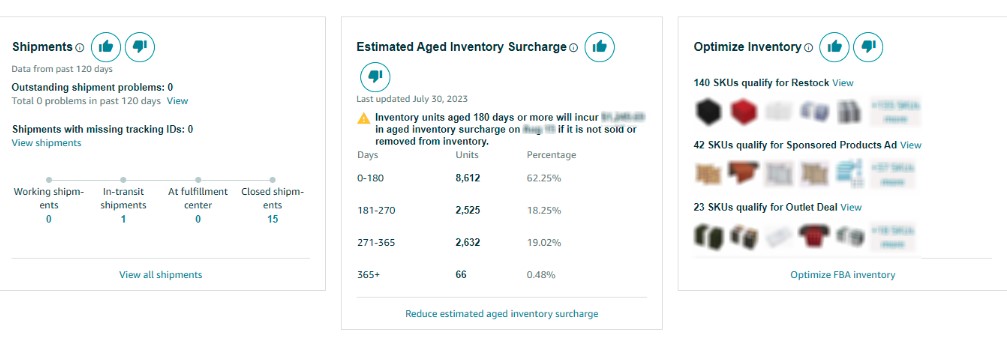
Spoilage
If you sell perishable or time-sensitive products like food products, supplements, or cosmetics that have expiration dates, managing your inventory effectively is of utmost importance. Failure to do so can lead to a loss of inventory due to expiration or spoilage, impacting your profitability and customer satisfaction.
By tracking your product’s expiration date you can avoid spoilage, and run those products on promotion or give discounts to the items that are at risk of spoilage.
Recommended read: Five Methods to Sell on Amazon Without Inventory.
High Storage Cost
Amazon charges storage fees based on your inventory volume stored in their fulfillment centers. High storage costs can eat into your profit margin, particularly if you hold excess or slow-moving inventory. The costs can be direct or indirect money you spend for the storage of these products. This storage cost can include costs for space, rent, electricity, and warehouse personnel.
The key is to efficiently manage your inventory and optimize storage space so you can reduce storage costs and improve profitability.
Low Stock Levels
Maintaining extremely low stock levels can lead to stockouts and disappointed customers. You must ensure adequate stock to meet customer demand and maintain a positive reputation. Consistently low stock levels can also affect your ability to fulfill orders promptly, potentially leading to negative feedback and a decline in rankings.
To thrive as an Amazon seller in the competitive marketplace, understand these common inventory challenges, and take appropriate actions so that you can enhance your inventory management practices.
Six Tips to Effectively Manage Your Amazon Inventory
To ensure your success as an Amazon seller, mastering proper inventory management skills is essential.
Let’s explore some valuable tips and strategies that will grant you greater control over your inventory:
Keep a Close Relationship with Your Supplier
Put in the effort to build and nurture strong relationships with your suppliers. Remember, they play a crucial role in bringing your product ideas to life. When you maintain a good rapport, your orders become a priority for them, reducing the risk of delays and stockouts. Respect and proper communication go a long way in establishing a mutually beneficial partnership.
Maintain Around 60 Days of Supply
Strive to keep approximately 60 days of inventory on hand to cover your expected sales volume. This balance helps you avoid both overstocking and going out of stock. By reviewing Amazon’s inventory reports and monitoring your sell-through rate, you can accurately forecast your sales volume.
Reduce Excess Inventory
If you find yourself with excess inventory, don’t panic. It happens to everyone, even big brands. There are several ways to deal with excess inventory on Amazon FBA. You can run promotions with discounts, coupons, or buy-one-get-one deals to accelerate sales for slow-moving inventory. Lowering your prices might incur a slight loss in the short term but could save you from long-term storage fees.
Plan for the Unexpected
Recognize that not everything will always run smoothly. Be prepared for potential delays with suppliers, shipping, customs, and FBA warehouses. Consider ordering backup units to maintain stock in case something disrupts your supply chain. Storing extra units in your warehouse or utilizing third-party storage and fulfillment centers are viable options to prevent stockouts.
Lower the Demand for Your Product if Running Low on Inventory
In the event of low inventory levels, you can influence demand by temporarily raising prices and pausing advertising campaigns. This approach helps maintain your in-stock rate and improves your IPI (Inventory Performance Index) score. Prioritize maintaining some inventory on hand rather than risking going completely out of stock.
Use Inventory Management Software
Stay ahead of your competition by leveraging advanced inventory management software. This powerful tool provides accurate demand forecasting for your Amazon FBA business. Predicting future sales based on demand helps you determine the right amount of inventory to order, ensuring you avoid both stockouts and overstocking.
To know more about inventory management tools, you can read this article.
By implementing these effective inventory management strategies, you’ll be well-equipped to optimize your inventory levels, maximize profits, and position yourself for long-term success on the Amazon marketplace. Stay proactive and in control, and watch your business flourish amid the dynamic and competitive e-commerce landscape.
Conclusion
As an Amazon seller, mastering the art of inventory management is the key to staying ahead of your competitors and ensuring the success of your business. Your inventory is the lifeblood of your operations on the Amazon marketplace, and proper management is crucial to meet customer expectations and avoid detrimental pitfalls.
So, embrace the intricacies of inventory management and seize control of your Amazon journey with confidence.
Your success awaits you!
Happy Selling!







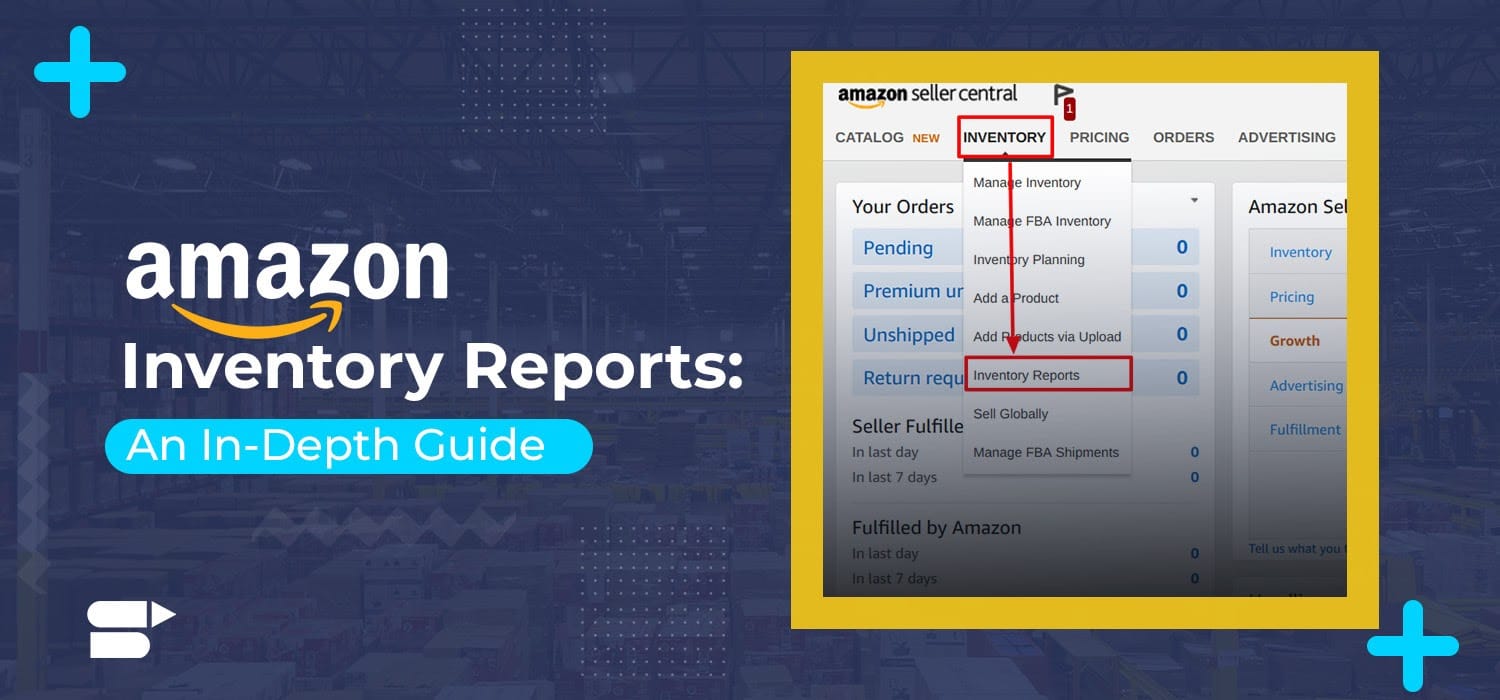

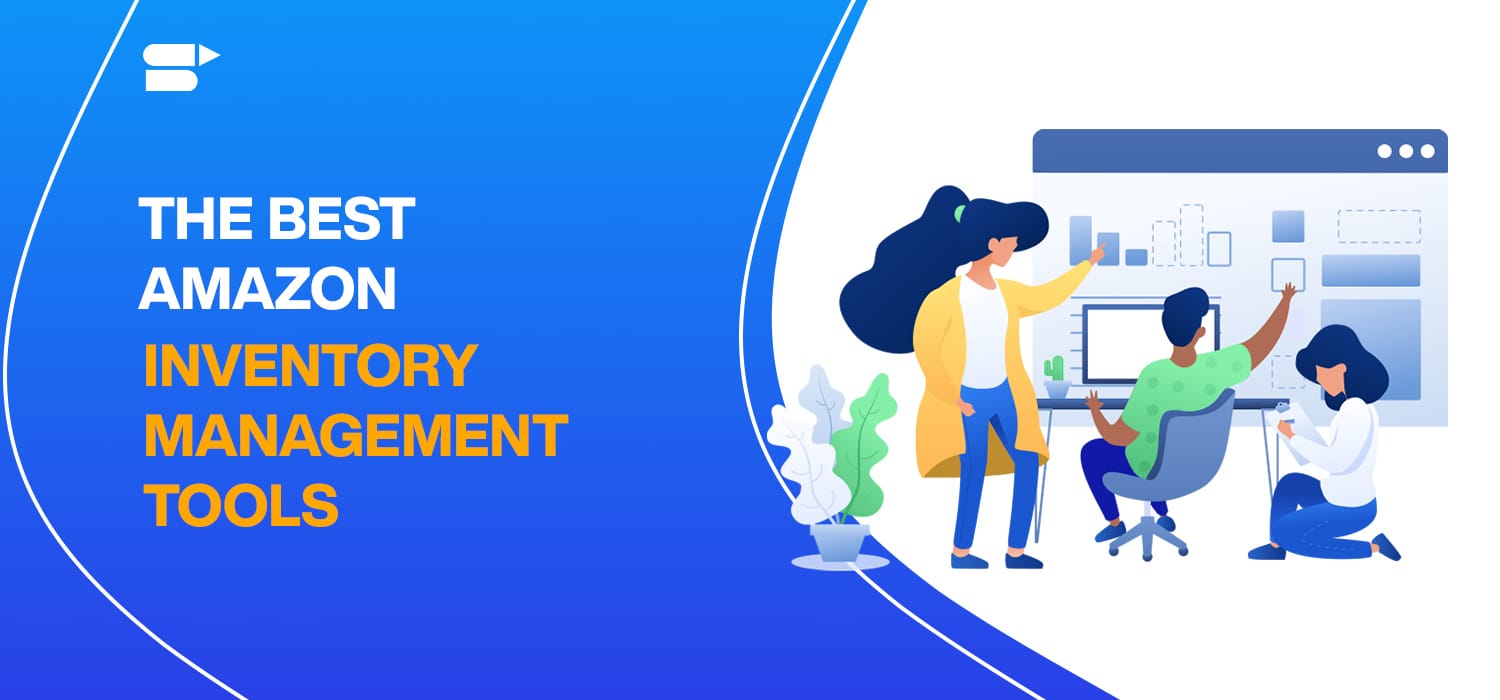
AnthonyReelf
April 21, 2021Good Resource for Amazon sellers.
Thank you guys.
Keep Posting
Arishekar N
June 29, 2021Thank you for sharing your experience with us.